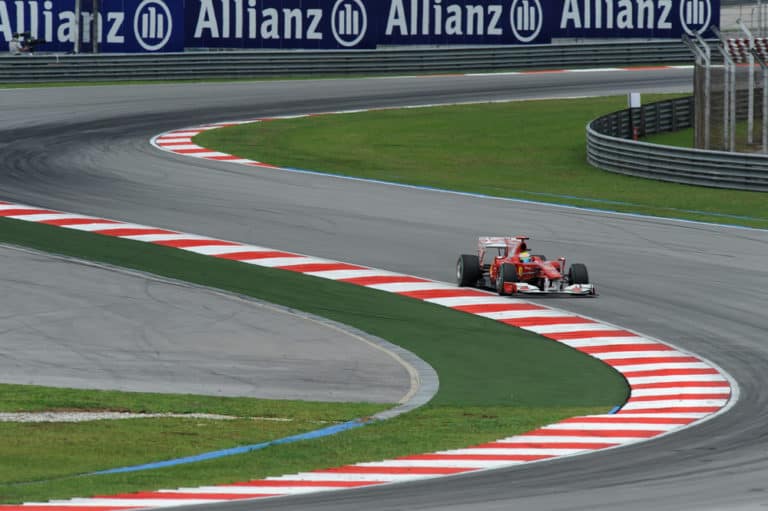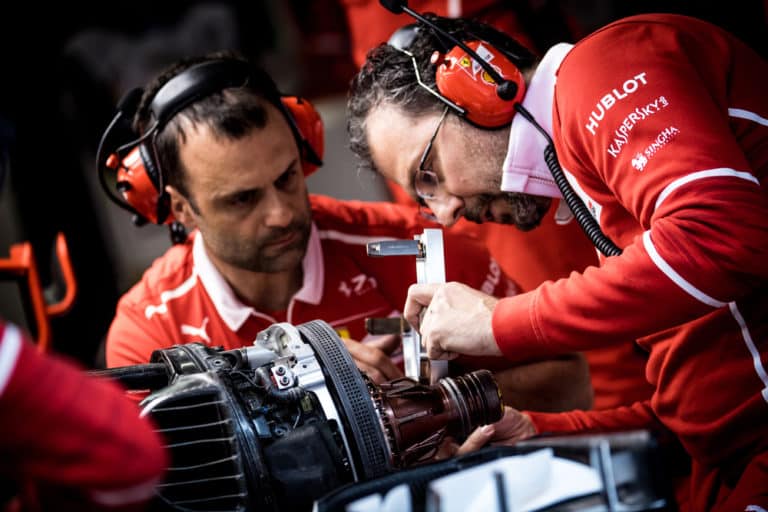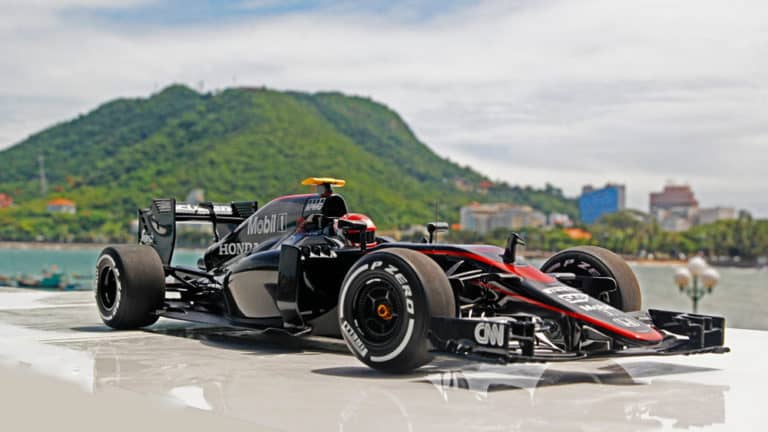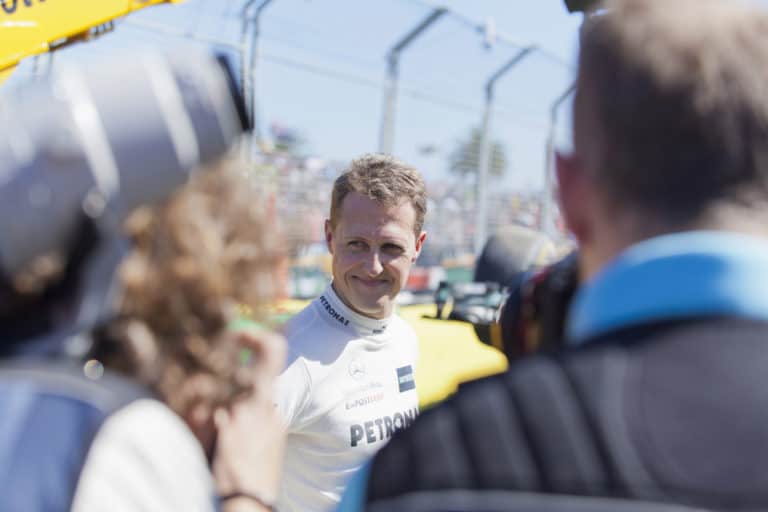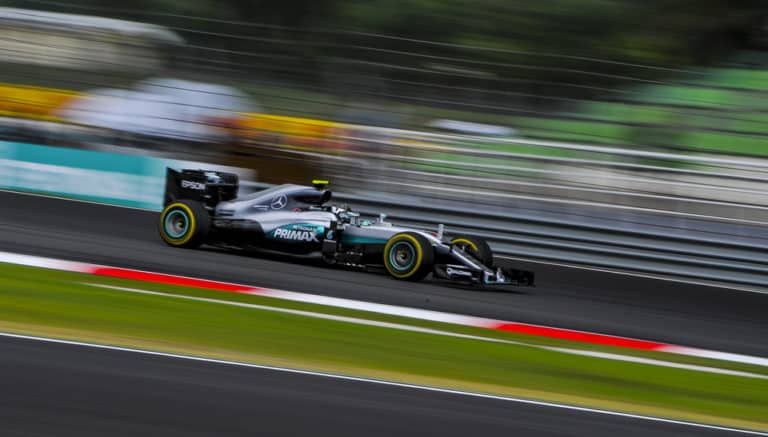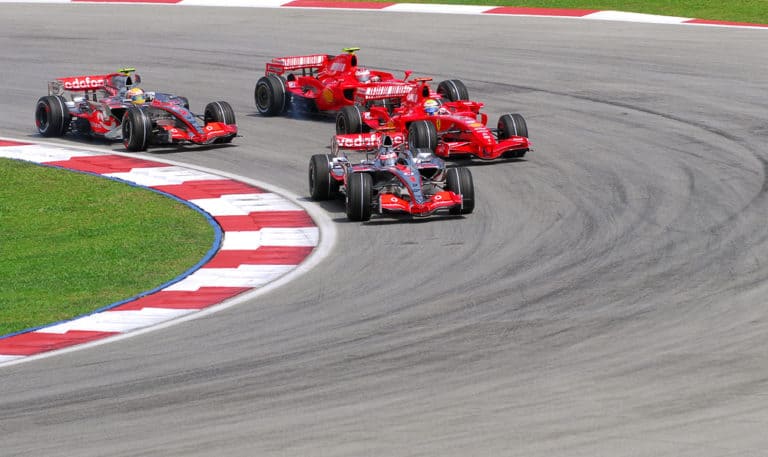Who is the engine running under the bonnet of the multi-million-dollar industry and second most-watched sport in the world? Who is breathing in the fumes of octane and success? Certainly, anyone who decides to get involved with a sport as ruthless and expensive as F1 must have some screws loose or knows how to grind people’s gears in their favor.
Liberty Media Corporation owns F1. This multimedia giant with various ties to organized sports is owned by John C. Malone, who would technically be described as the owner. Previous F1 owners are often cited as CVC Capital Partners and Bernie Ecclestone.
F1 enjoyed its rich history of dramatic acquisitions and court battles. Various rich and influential businesspeople have competed to claim the controlling interest of this racing giant. The history of the sport, its previous owners, and its potential to create or destroy moguls is interesting enough to read.
If you’re looking for some F1 merchandise, check out the awesome stuff at the official F1 store here.
Who owns F1?
The Formula One racing series is owned by an American media giant, Liberty Media Corporation. Liberty Media is owned by the founder and chairman, John C. Malone, an enterprising businessman with a long history in the media industry. John C. Malone has often been called the “Cable Cowboy.”
Liberty Media Corp is run by CEO and company president Greg Maffei. Under the guidance of Maffei and Malone, the company has enjoyed immense success, expanded into new sectors, and acquired various major assets.
Liberty’s three divisions reflect the controlling interests they own in various businesses. These divisions include the Braves franchise (including the Atlanta Braves MBL team), the SiriusXM Group (focused on radio broadcasting and ticket promotion and sales), and the Formula One Group.
A Quick Rundown Of The Acquisition
In January 2017, Liberty acquired the Formula One Group from Delta Topco (formerly owned by CVC Capital Partners) at a final cost of $4.6 billion. This price is contrasted to the initially expected cost to acquire the franchise, which was widely contested to be around $8 billion, but this number reflects the enterprise value.
Enterprise value essentially refers to the value of a company, and it is calculated by adding its market capitalization and debt while subtracting its available cash. This formula assumes that an acquiring company acquires its target’s value, assets, and debt.
Liberty Media Corporation (LMC) acquired F1 by buying out its market capitalization. Market capitalization is almost interchangeable with equity value, except that it only bothers measuring the total ordinary share value. When settling the deal, Delta Topco’s Formula One boasted a market cap of $4.6 billion.
The acquisition, however, only cost Liberty Media $301 million of their cash, while the rest of the deal was financed by debt, a share offering, and exchangeable debt. It took Liberty Media roughly three years to decide whether or not they would buy F1. After they decided it was the right call, it took another couple of months to finalize the sophisticated financing structure they ended up using.
Here is a summary of the different sources of financing LMC prepared:
- Using their Time Warner shares as collateral, LMC borrowed $445 million.
- Using their Live Nation shares as collateral, LMC borrowed $350 million.
- LMC was able to acquire an additional $400 million in debt.
- LMC’s F1 tracking stock generated $1.55 billion (62 million shares at $25) from seven investment funds.
- $301 million of cash from LMC’s reserves.
- All of the sources of financing above resulted in cash paid to the sellers (around $3.05 billion).
- Equity-wise, LMC gave the sellers 56 million shares in their F1 tracking stock to the value of $1.2 billion.
- Finally, LMC also issued the sellers $351 million worth of exchangeable loan notes (exchangeable to the F1 tracking stock).
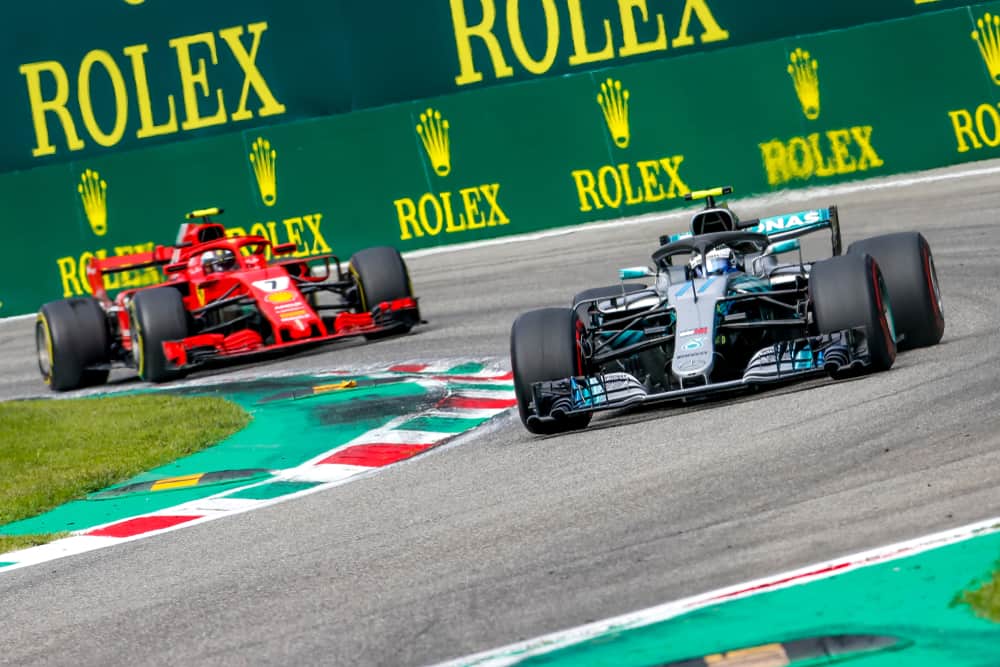
A Brief History Of Formula One And Its Owners
Formula One’s roots trace way back, and a lot has happened to produce the heart-racing, nail-biting motorsport many fans enjoy today. Despite a couple of ups and downs in popularity, the sport is now enjoying the most success it ever has – especially among younger audiences. We must look back at its origins to understand how it got to where it is.
It all dates back to France on 20 June 1904, when an organization called the Fédération Internationale de l’Automobile (FIA)was founded under its original name Association Internationale des Automobile Clubs Reconnus (AIACR). The purpose of the FIA was to protect the rights of French motorists, but eventually, in the 1950s, its responsibilities grew considerably greater.
Although, technically speaking, motorsport racing has existed since gasoline-combustion engines were invented and widely available, the origins of Formula One are almost synonymous with the Grand Prix. The word “Grand Prix” was first used to refer to a race dating back to 1901, but the more important one would occur on 26 June 1906, at Le Mans.
Initially inspired by the Gordon Bennet-style races (founded to inspire competition in the industry), this still novel idea completely captivated the primarily French audience, with petrol filling their noses all around. 12 manufacturers provided 32 cars, and they would race in a marathon consisting of 770 miles within two days. Racers would take off at 90-second intervals, and the race was essentially a time trial.
The cars could drive at a top speed of about 70 miles per hour, but there were many technical failures. Mechanics were sitting alongside their respective drivers, and only these members could work on the cars during pit stops. Resultingly, only 11 crossed the final finish line. In the end, the Hungarian Ferenc Szisiz driving for the French Renault team was the victor of the first Grand Prix.
The Grand Prix at Le Mans (often called the Grand Prix) has achieved legendary status as the first real and regulated international motor racing competition in the racing world. The Automobile Club of France organized this infamous race.
However, the Grand Prix racing style was criticized for taking too long and lacking interaction between the respective competitors. Furthermore, rules stipulating that only the driver and their sitting mechanic could facilitate pitstops resulted in too many cars retiring due to mechanical failures. Many people preferred the Gordon Bennet-style races.
Nevertheless, the sport had already taken off and had a massive influence on the automobile industry. Renault’s sales nearly doubled two consecutive years after winning the 1906 Grand Prix (despite most of their cars not finishing the race). These types of races started becoming increasingly frequent and organized.
Over the earlier years, most races were planned on public roads outside and between major European and US cities. Construction for three circuits intended solely for motor racing took place: the Brooklands Circuit in England, the Indianapolis Motor Speedway in the US, and the Autodromo Nazionale Monza in Italy. There hadn’t been a formal championship yet.
The auto racing association called the Association Internationale des Automobile Clubs Reconnus set the rules and requirements for organized motor racing dating back to 1922. However, the AIACR’s rules and regulations were soon cast aside in 1928. For some time, the sport entered the “Formula Libre” era, meaning “free formula,” and races took place with almost no concern for rules.
In 1925, the first manufacturers’ World Championship took place, consisting of four races: the Indianapolis 500 and the respective Grand Prix of Europe, France, and Italy. This perspective on world championships helped pave the road for the Formula One we know today.
In 1933, the Monaco Grand Prix became the first race where organizers decided to use grid-like starting positions based on qualifying times. The grid system is one of the first regulations that survived to be included in modern F1 racing (along with engine size and vehicle weight restrictions).
Shortly after the end of World War II, motor racing took off again. Although the previous World Championships already had an extensive list of rules, a modernized version was necessary. The AIACR was renamed and became the FIA that is still around now. Around the same time, in 1946, Formula One became recognized as a legitimate set of motorsport regulations.
At the turn of the decade, organizers announced that a Formula One Grand Prix World Championship would take place the following year. The first World Championship F1 race after WW2 occurred at the United Kingdom’s Silverstone circuit on 13 May 1950. Although organizers announced almost 30 planned races for 1950, only 7 of these counted towards the championship.
At Silverstone, Giuseppe Farina became the first driver to win an F1 championship race (there had been a non-championship F1 race at Pau in France just a month before). However, the more prominent driver for the rest of the decade was Juan Manuel Fangio, the driver’s cup victor for five years with five different manufacturers.
Due to a lack of cars complying with the F1 rules and a resulting lack of entrants to the 1952 and 1953 seasons, the championships used F2 regulations. Costs were also high, and many manufacturers had to drop out due to a lack of financing. Races were very dangerous, and many fatal crashes ensued over the first decade, with 13 drivers killed in races.
Ecclestone And The FISA-FOCA Battle For Ownership
For a good reason, Bernie Ecclestone is often called “F1 Supremo” by journalists and fans of the sport. He is essentially one of the original owners of Formula One, and his ties to the sport go back to the decade of its inception.
Over the 1958 F1 championship season, Ecclestone entered races as a driver twice. Unfortunately, on both occasions, he failed to qualify. Determined to be part of the motorsport culture and with a fascination for the industry in his heart, Ecclestone persevered. He later became the manager of two drivers: Lewis-Evans and Jochen Rindt.
In 1971, Ecclestone became the owner of the Brabham racing team after making an offer of approximately $120,000 for the lot. Ron Tauranac, who initially approached Ecclestone looking for a viable partner, naturally accepted. This move secured Eccleston’s influence in the Formula One landscape.
He would eventually change many things about the team and the Brabham company. He abandoned the consumer motor industry and focused all his time and resources on Formula One racing. With various team members coming and going, many innovative ideas were entering the team, leading to new technology which would help them take numerous victories in 1974 and ’75.
The team continued to do well until the mid-80s but eventually lost much of the momentum they’d built up over the 70s. Their best drivers left for higher-paying teams until, in the 1987 season, Brabham scored a mere eight points. Ecclestone sold the team in 1988 to Joachim Luhti for over $5 million.
Ecclestone used his influence and expertise in the field to form the Formula One Constructors Association (FOCA) in 1974 alongside Colin Chapman, Frank Williams, Ken Tyrrell, Max Mosley, and Teddy Mayer. This association gave Bernie Ecclestone the platform he needed to negotiate for TV rights and other important additions to the sport.
In 1978, Ecclestone became CEO of the FOCA with the support of Max Mosley as his legal adviser. These two were a great combination and soon became a force to be reckoned with, winning television rights and presenting British teams with more bargaining power than they’d previously enjoyed.
This increased bargaining power caught the attention of Jean-Marie Balestre, who at that time was the chief of the Fédération Internationale du Sport Automobile (FISA). Ecclestone and Balestre could be likened to each other’s natural rivals – hence the origination of the FISA-FOCA war.
A series of actions ensued to get their respective organization to the top. From boycotting and scheming to fining and taking officials out dining, these two tried to get to the other just to get outmaneuvered again.
The FISA-FOCA war was simple: many teams struggled to compete with some larger and richer competitors, such as Ferrari and Renault. Therefore, they pushed for more regulation for fair competition and the distribution of revenue made from races.
The 1980 Spanish Grand Prix could be the first real battlefield for these giants to fight. While skirmishes had taken place here and there, FISA fined all the drivers who hadn’t appeared at the Belgian and Monaco racers’ briefings this time. Unless racers paid the fines, the accused drivers would have their racing licenses revoked by the FIA. Eventually, they raced anyway.
In the 1982 season, there was a drivers’ strike at the South African GP. This time, it was regarding the drivers’ super licenses. FISA introduced a clause stipulating that the drivers could only race for the team they were contracted to at the moment and no others. After many debates and negotiations between FOCA, FISA, and GPDA, the parties settled the dispute in favor of the drivers.
Balestre and Ecclestone kept their battle of the wits going for quite some time; however, neither of their feelings of pride would allow the one to concede to the other. Eventually, the parties compromised since F1 management couldn’t allow any more races to be canceled or declared non-championship titles, but Bernie Ecclestone found the most favorable outcome.
The Concorde Agreement establishes Ecclestone’s victory. The First Concorde Agreement was signed on 19 January 1981 in Place de la Concorde. It contained the various terms and conditions that F1 teams adhere to, how funds will be managed and distributed and other technicalities.
Arguably the most important aspect of the Concorde Agreement was the agreement on who should own the television rights for the sport. According to the contract, it is “leased” to Formula One Promotions and Administration (FOPA), a company that Bernie Ecclestone found and controlled himself. The Concorde Agreement sought to stabilize the sport’s rules to protect it from the governing body’s sudden changes.
With the shift of television rights, Bernie Ecclestone had essentially secured his spot in the ownership of the sport. However, the concord agreement had to be updated every few years. FOPA later became known as the FOM (Formula One Management).
According to the second Concorde Agreement (1987), TV revenue would be split up as follows:
- 49% of revenue goes to FOM, along with the responsibility of paying fees and prize money.
- 1% of revenue goes to the teams.
- 50% of revenue gets distributed to the FIA.
Ecclestone Starts Cutting Back On His Ownership
A holding company, SLEC Holdings, was founded in 1996 to take a controlling interest in the F1 Group. Soon other private investment companies became interested in holding a portion of the lucrative F1 business.
The following transfers in ownership took place following the founding of SLEC Holdings:
- In June 1999, Morgan Grenfell Private Equity paid SLEC holdings £234 million (around $254 million) for a 12.5% stake in the company.
- Later, in February 2000, Hellman and Friedmann acquired a 37.5% stake in SLEC Holdings for £625 million (or around $575 million).
- Hellman and Friedman combined their share with Morgan Grenfell and created Speed Investments, which owned 50% of SLEC Holdings.
- In March 2000, the German media giant EM.TV Merchandising purchased Speed Investments for a whopping £1.1 billion (roughly $1 billion).
- When EM.TV revealed its poor financial position to the public, the Kirch Group decided to step in and consequently took over Speed Investments.
- EM.TV and Kirch decided to exercise an option to acquire an additional 25% of SLEC Holdings, therefore raising their shared ownership of SLEC to 75%.
- To finance these purchases, the Kirch Group eventually took out major loans they could not repay.
- The banks that gave the group their loans put the company into receivership in 2002.
- The Kirch Group, therefore, transferred its shares in SLEC Holdings to Bayerische Landesbank, JPMorgan Chase, and the Lehman Brothers.
- While the transfer, as mentioned above, was still awaiting clearance, Ecclestone installed changes to the boards of SLEC, FOM, and other companies controlling and managing the sport to put Bambino Holdings in charge.
- In 2004, the banks that took over Speed Investments sued Ecclestone to claim the share ownership they felt was rightfully theirs.
- The court agreed with the banks, and Ecclestone had to comply with the banks’ wishes. Ecclestone, however, claimed that the verdict was meaningless, and he said he would appeal.
- The day following the verdict, Ecclestone – at a meeting with the team bosses – offered the teams a sum of £260 million (or $290 million) paid over three years, gunning for the renewal of the Concorde Agreement.
- Eventually, a couple of weeks later, the new chairman of SLEC Holdings and board member of Bayerische Landesbank, Gerhard Gribkowsky, consoled Ecclestone telling him that the banks now in control of F1 had no interest in removing him from his position of power.
CVC And Liberty Media Acquisitions
The four banks that had acquired Speed Investments held onto their controlling interest until the end of 2005 when new interested parties stepped up to make offers. The last two decades of F1 ownership changes were less dramatic than the preceding years, but it’s equally important to consider.
The following changes in ownership of F1 took place since the start of 2005:
- CVC Capital Partners acquired 25% of Bambino Holdings and 48% of Bayerische Landesbank’s shares in SLEC in November 2005.
- In December 2005, all of JPMorgan Chase’s shares in SLEC were bought by CVC Capital Partners.
- Finally, in March 2006, CVC Capital Partners acquired majority ownership in SLEC by purchasing the share held by the Lehman Brothers.
- This purchase gave birth to a new holding company called Alpha Prema, and Ecclestone used the proceeds of the Bambino share sale to reinvest in this new holding company.
- Ecclestone remained CEO of the F1 group after this purchase.
- Ecclestone also supported the purchase of F1 by CVC, stating that they would be the ideal partners to take the business to the next level as they had a lot of experience in motorsport already.
- In 2015, according to research cited by the Guardian, F1 had already made more than $14 billion for its owners through shares and dividends.
- $4.4 billion of this whopping figure can be attributed to money gained by CVC from their share sales, proving that they benefitted from their investment.
- Eventually, Liberty Media stepped in and offered to purchase the Formula One Group in late 2016.
- On 23 January 2017, the parties finalized the deal, and Liberty Media purchased the Formula One Group for $4.6 billion.
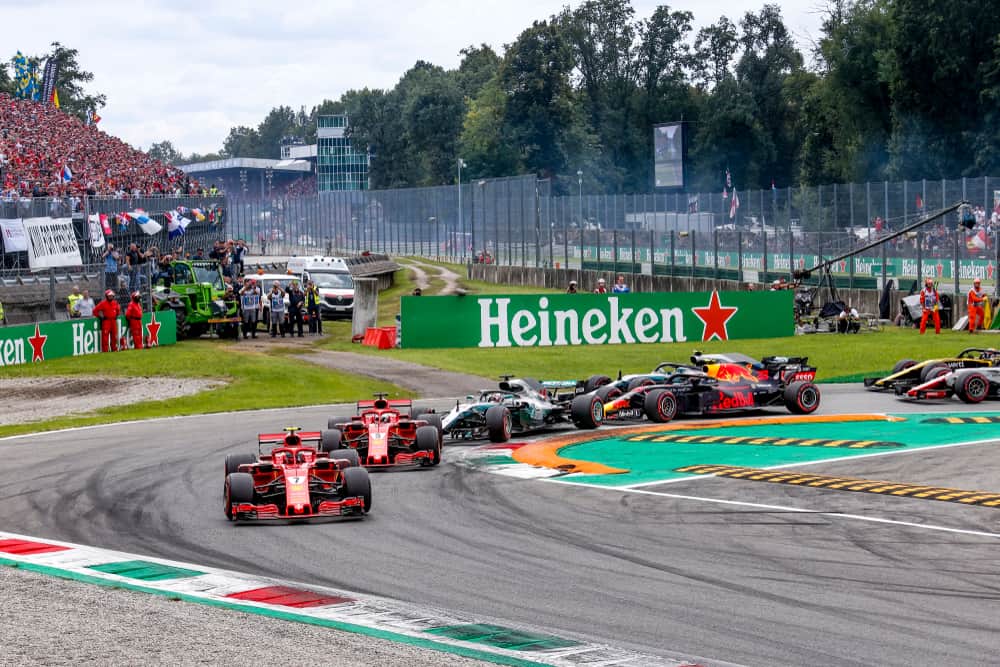
How Has Liberty Media Changed F1 So Far?
After Liberty acquired the Formula One Group, many changes came to the management of the sport. For starters, Bernie Ecclestone stepped down as CEO of the group and got replaced by Chase Carey in 2017.
Later, in January 2021, Chase Carey was replaced by Stefano Domenicali. Under the leadership of these two new CEOs, the sport has changed a lot since 2017. Fans aren’t all in agreement on whether or not these changes are for the best, but according to statistics and rapidly rising viewership amongst younger generations, one could argue that these changes are certainly contributing to massive success.
The first changes came to the sport’s branding, with Liberty Media announcing massive changes to their logos, new theme songs, new on-screen displays during races, and all sorts of other visual revamps. It all made the sport more modernized and focused on technological advancements on and off the track.
Under Bernie’s leadership, F1 had scarcely scraped the surface of the social media frontier. With F1’s newfound guidance under Liberty Media, the sport has certainly seen an increased profile online with almost daily posts on their various accounts. F1’s YouTube presence grew from 272,000 subscribers in five years to roughly 7 million.
Another boost to F1’s viewership indisputably comes from the hit Netflix series, Drive to Survive. This series has been especially effective in raising awareness of the sport among younger viewers and older novices. Although many of the show’s stories have been dramatized, many teams and drivers are happy to share more of their experiences.
Furthermore, Liberty Media introduced a budget cap to the sport, stipulating strict budgetary restrictions on the manufacturers’ spending. Marketing budgets and salaries for managers and drivers are excluded. Regardless, this has made the sport fairer than it previously had been.
Ecclestone has repeatedly criticized journalists, politicians, and others for his offensive views on women. Liberty Media decided to eliminate the grid girls (glamorous models indicating drivers’ slots on the grid at the start line) from the sport, something Ecclestone didn’t want to do.
Conclusion
The future of F1 is as bright as its history is rich. Ecclestone certainly left his mark on the sport, but his reign is over, and Liberty Media is doing a good job managing the success he had ensured for generations to come.

